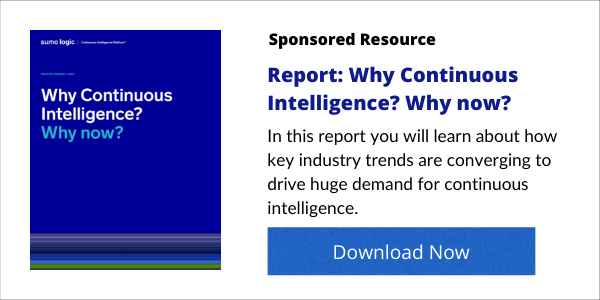
Enterprise cloud migrations and the continued increased use of cloud intros new performance monitoring and management demands.
Cloud operations found its stride during the pandemic and shows no signs of slowing down. Gartner believes spending on public cloud services will reach $480 billion in 2022 and will comprise more than 45% of enterprise spending by 2026. Certain trends mark where enterprise cloud strategy could go for 2022 and beyond.
Application restructuring will become critical
During the pandemic, the hasty move to cloud operation allowed many enterprises to remain afloat even with in-person restrictions. Now that we’re several years in, they’ll begin examining applications shoved as-is into the cloud.
Download Infographic Now: The 5 intelligence gaps curbing your climb to digital successCompanies will need to reexamine the applications to ensure they’re taking full advantage of what the cloud can offer—self-service and scalability, among others. Taking this approach not only reduces cost. It builds back a better architecture with less friction. This is critical to weather further disruptions. Established frameworks such as the Azure Well Architected Framework can offer companies a foundation to rebuild.
See also: Why Observability is Needed in Cloud Migrations
Companies will demand reduced complexity
And speaking of rebuilding applications, a subsequent trend could be the focus on reducing the complexity of working within the cloud and a rebalance between on-premises and cloud services for enterprises straddling the line.
Part of the equation is moving to more platform-agnostic solutions and more usage of hybrid clouds. Companies that have moved beyond the initial cloud trials can leverage hybrid cloud to manage multiple cloud environments from different providers and hide what’s going on behind the scenes when it isn’t expressly necessary.
A hybrid cloud splits data between the frequently accessed, rapid iteration of anonymized data and the sensitive, private data necessary for some operations. The bulk of processing can happen on more cost-effective public clouds while mission-critical goes through proprietary applications. This hybrid system can free up enterprises from the “all or nothing” dance and allow them to rebuild to take full advantage of cloud features.
Artificial intelligence and the cloud deepen their bonds
AI-enabled cloud services is one of Gartner’s top trends in their recent report focused on cloud services. This could mark a critical juncture for the cloud as it becomes more complex. Using machine learning and other algorithms, companies and providers could manage services more efficiently and eliminate the need for risky (and costly) I&O roles.
Programmable infrastructure needs fewer manual operations and interventions to scale. This focus on allowing AI to do what it does best could help enterprises get over the hurdle of moving entirely to the cloud.
The influence goes both ways. Cloud delivery makes creative algorithms possible for a broader range of customers. For example, natural language processing, which is designed to teach robots to interact with human language, or processing algorithms that teach bots to create artwork best when delivered in the flexible environment of the cloud. They will continue to influence each other.
Serverless cloud could hit its stride
Serverless cloud adds a layer of abstraction between the client and the provider. Enterprises no longer need to consider how much storage to pay for or scale the applications. The infrastructure scales behind the scenes, allowing enterprises a true “pay as you go” choice.
This flexibility is attractive because companies can scale up or down automatically. Without the constraints of an architecture that chafes as business changes, this could offer the enterprise opportunities for growth or innovation.
Function-as-a-Service providers are already springing up and want to make the entire experience seamless. This will continue as enterprises seek to future-proof operations against disruptions like the pandemic.
Cloud-native continues to rule
Instead of the usual lift and shift approach at the beginning of a transformation, companies will most likely prioritize applications built specifically for the cloud. They’re easier to deploy and far easier for enterprises to maintain, including security.

It’s helping companies embrace the cloud fully, even if they started with some reservations. They provide a foundation for agile operations and responsiveness. In fact, working with cloud-native applications could even improve time to market.
Industry-specific cloud offerings
Companies compete for tech talent and increasingly turn to service providers to handle the load. Cloud providers and cloud-native third parties can step into the gaps to fill industry-specific needs.
Because cloud-native applications are becoming more common, enterprises can leverage them to achieve goals or complete services as they need them.
Cloud spending will continue
Right at the height of the pandemic, businesses seemed to turn away from IT spending. That changed when the disruption lasted well beyond the initial two to three-week mark. Now that remote work, flex work, and data-driven decisions are the new normal, and cloud spending is on the rise.
Cloud remains a strategic investment, but it doesn’t always follow general IT spending. Covid-19 revealed quickly that companies wouldn’t always tie cloud budgets and investments to their traditional IT budget—this includes cloud budgets replacing traditional IT. This concept also demonstrates that cloud investments supported only by IT, as opposed to enterprise-wide adoption, will not be as successful.
Related: What is Continuous Intelligence?
Sustainability is a significant focus
The cloud makes a multitude of applications lighter, faster, and more efficient. As companies focus on climate change and environmental impact, cloud innovations follow. Right now, reducing the environmental impact of expensive, “always-on” processing is high on the list, as well as ensuring that even storage requirements run efficiently.
Companies are also using the cloud to adopt a composable architecture, which allows them to reduce unnecessary processing and storage without disrupting the entire ecosystem. Big tech is focusing on technologies that get them closer to their net-zero carbon goals, and the cloud could be a significant factor in whether those goals are met.
Enterprise cloud strategy is moving forward
With each of these trends, enterprise cloud moves towards greater adoption. While it’s impossible to know what will happen in the future, it’s clear that the cloud will continue to hold a lot of potential for enterprises looking to expand operations while maintaining flexibility. It offers the potential for innovation and may help enterprises ride out future disruptions.
Download Infographic Now: The 5 intelligence gaps curbing your climb to digital success





